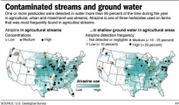Pesticides Found in Rivers and StreamsThroughout the U.S.
Pesticides Found in Most U.S. Rivers
By JOHN HEILPRIN, Associated Press Writer
March 4, 2006
WASHINGTON - Most of the nation's rivers and streams — and the fish in them — are contaminated with pesticides linked to cancer, birth defects and neurological disorders, but not at levels that can harm humans.
Pesticides were found in almost all U.S. rivers and streams between 1992 and 2001, says a study released Friday by the U.S. Geological Survey, although most drinking water supplies haven't been affected.

"While the use of pesticides has resulted in a wide range of benefits to control weeds, insects and other pests, including increased food production and reduction of insect-borne disease, their use also raises questions about possible effects on the environment, including water quality," said Robert Hirsch, the USGS associate director for water.
Pesticides were seldom found at concentrations likely to affect people, and they were less common in groundwater. But they were found in most fish.
Most frequently detected in agricultural streams were three herbicides used mainly on farms: atrazine, metolachlor and cyanazine. Just last week, the Environmental Protection Agency settled a 2003 lawsuit brought by the Natural Resources Defense Council, forcing the government to assess whether atrazine threatens the survival of endangered Chesapeake Bay sea turtles, endangered Texas salamanders and 16 other aquatic species.
Three other herbicides used commonly in cities — simazine, prometon and tebuthiuron — showed up more often in urban streams.
The USGS looked for 100 pesticides, and found 40 of them had a widespread presence in streams and sediment in both urban and agricultural areas, at concentrations that could affect aquatic life or fish-eating wildlife. The pesticides showed up more than 90 percent of the time in the fish tissue found in agricultural, urban and mixed land-use areas.
In each of the streams the USGS studied, at least one pesticide was detected. In about 19 of every 20 streams with agricultural, urban or mixed land-use watersheds, pesticide compounds were found at nearly all times of the year. The most frequent occurrence was in shallow groundwater beneath agricultural and urban areas, where more than half the wells contained one or more pesticide compounds.
Jay Feldman, executive director of Beyond Pesticides, a national research and advocacy group, said the data surrounding the nation's reliance on about 1 billion pounds of pesticides a year "shows an urgent need to strengthen policies at all levels of government and curtail pesticide use."
The USGS report is based on an analysis of data from 51 major river basins and aquifer systems nationally, and a study of an aquifer system that runs through eight states from South Dakota to Texas, east of the Rocky Mountains.
It found that concentrations of individual pesticides nearly always complied with the EPA's drinking-water standards, though no water samples from streams were taken at drinking-water intakes. The EPA also is responsible for reviewing pesticides, based on pesticide-makers' tests that can cost tens of millions of dollars. It typically takes up to a decade to study each one before it can reach the marketplace, according to industry figures.
But simply detecting the presence of a pesticide does not always mean there is reason for concern, said Jay Vroom, president of CropLife America, which represents pesticide developers and manufacturers. He emphasized that the use of pesticides by farmers, ranchers and others is strictly regulated by federal and state laws.
"Water quality is of paramount importance to us," he said. "And the USGS report correctly recognizes that the large majority of pesticide detections in streams and groundwater were trace amounts, far below scientifically based minimum levels set for protecting human health and the environment."
***
Note: Some day we're going to look back at these trace levels of pesticides and find that they have major impacts on our health. I guarantee that. Fortunately, pesticides are easily removed from your water.
Return to the Resource Library

James P McMahonEcologist
"What's in YOUR Water?"
 ©
©
Sweetwater, LLC
Return to:
Home Water Purification Systems
* * *
Home Water Purification Systems Air Purification Consultations Buy my Ultimate Guide Resource Library
Water Purifiers Arsenic Iron Removal Commercial Healing Waters Rainwater
Whole House Water Purification Water Testing Healthy Links Biography Well Water Rave Reviews



